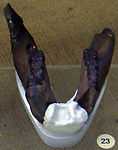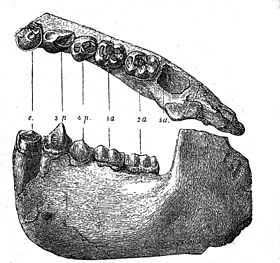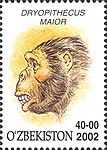Dryopithecus
| Dryopithecus Temporal range: 12–9Ma | |
|---|---|
| | |
| Mandible fragment of Dryopithecus fontani from Saint-Gaudens, France (Middle Miocene, 11,5 My) ; cast from Museum national d'histoire naturelle, Paris | |
| Scientific classification | |
| Kingdom: | Animalia |
| Phylum: | Chordata |
| Class: | Mammalia |
| Order: | Primates |
| Superfamily: | Hominoidea |
| Family: | Hominidae |
| Subfamily: | Homininae |
| Tribe: | Dryopithecini |
| Genus: | Dryopithecus† Lartet, 1856 |
| Species | |
| |
Dryopithecus was a genus of apes that is known from Eastern Africa into Eurasia during the late Miocene period. The first species of Dryopithecus was discovered at the site of Saint-Gaudens, Haute-Garonne, France, in 1856.[1] Other dryopithecids have been found in Hungary,[2] Spain,[3] and China.[4]
Like Sivapithecus, Dryopithecus was suspensory, had a large brain, and a delayed development, but, unlike the former, it had a gracile jaw with thinly enameled molars and suspensory forelimbs; Begun 2004 notes that the similarities and differences between them provides insight into the timing and paleogeography of hominid origins and the phylogenetic divide between Asian and Afro-European great apes. [5]
Description
Dryopithecus was about 4 feet long, and more closely resembled a monkey than a modern ape. The structure of its limbs and wrists show that it walked in a similar way to modern chimpanzees, but that it used the flat of its hands, like a monkey, rather than knuckle-walking, like modern apes.[6] Its face exhibited klinorhynchy, i.e. it was tilted downwards in profile.
It likely spent most of its life in trees, and was probably a brachiator, similar to modern orangutans and gibbons. Its molars had relatively little enamel, suggesting that it ate soft leaves and fruit, an ideal food for a tree-dwelling animal.[6]
The five-cusp and juvenile[7] fissure pattern of its molar teeth, known as the Y-5 arrangement, is typical of the dryopithecids and of hominoids in general.
Additional images
|
See also
Notes
References
- Begun, David R. (2004). "Sivapithecus is east and Dryopithecus is west, and never the twain shall meet". Anthropological Science 113 (1): 53–64. doi:10.1537/ase.04S008. CiteSeerX: 10
.1 ..1 .88 .1617 - Harrison, Terry; Ribot, F; Gibert, J (1996). "A reinterpretation of the taxonomy of Dryopithecus from Valles-Penedes, Catalonia (Spain)" (PDF). Journal of Human Evolution (31): 129–141. Terry Harrison's faculty page
- Kordos, László; Begun, David R. (2001). "A new cranium of Dryopithecus from Rudabánya, Hungary" (PDF). Journal of Human Evolution 41 (41): 689–700. doi:10.1006/jhev.2001.0523.
- Palmer, D, ed. (1999). The Marshall Illustrated Encyclopedia of Dinosaurs and Prehistoric Animals. London: Marshall Editions. p. 292. ISBN 1-84028-152-9.
- Pilbeam, David; Simons, E. L. (February 1971). "Biological Sciences: Humerus of Dryopithecus from Saint Gaudens, France". Nature 229 (5284): 406–407. doi:10.1038/229406a0. PMID 4926991.
- Simons, E. L.; Meinel, W. (1983). "Mandibular ontogeny in the miocene great apeDryopithecus". International Journal of Primatology 4 (4): 331–162. doi:10.1007/BF02735598.
- Xue, Xiang-Xu; Delson, Eric (1989). "A new species of Dryopithecus from Gansu, China" (PDF). Chinese Science Bulletin (34): 223–230.


